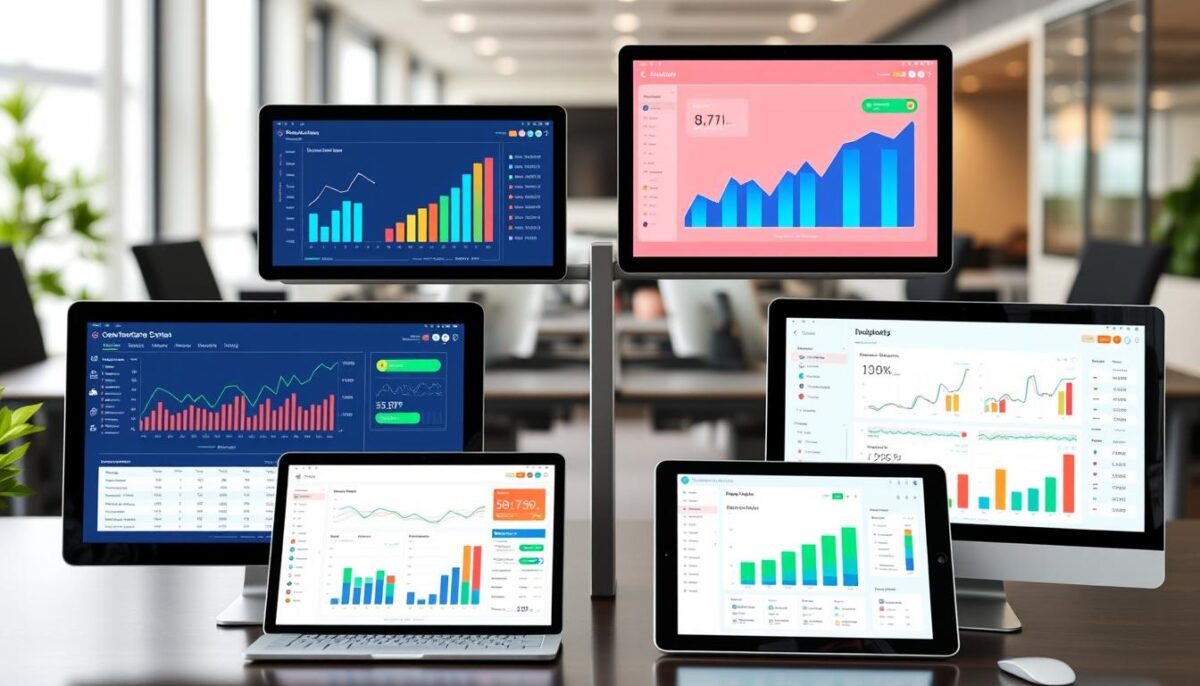Financial management is changing fast, and the right tools are key. In 2024, businesses need to use the latest budgeting and reporting software. This helps them work better, make smarter choices, and succeed financially. But, what are the top tools that can really help your business?
Key Takeaways
- Discover the leading budgeting and reporting software solutions for 2024
- Understand the importance of these tools in modern financial management
- Explore the key features and benefits of budgeting software for businesses
- Learn how reporting software can enhance business decision-making
- Gain insights into the latest trends and best practices in financial software
Understanding the Importance of Budgeting Software
In today’s fast-paced business world, managing money well is key to success. Budgeting software changes how companies handle money, making it easier to track expenses and plan finances.
Benefits of Budgeting Software for Businesses
Using budgeting software can greatly benefit businesses of all sizes. It makes financial tasks smoother, more accurate, and saves time. With tools like real-time reports and customizable dashboards, companies can understand their finances better. This helps them make smarter choices and plan ahead.
- Improved financial accuracy and transparency
- Automated expense tracking and forecasting
- Increased productivity and time savings
- Enhanced budgeting and planning capabilities
- Seamless integration with other financial tools
Key Features to Look For
When looking at budgeting software, focus on what your business needs. Look for tools with strong reporting, customizable dashboards, and easy integration with your current expense tracking and forecasting software. Also, consider how easy the software is to use and if there’s good customer support.
“Budgeting software has transformed the way we approach financial management, saving us time and providing valuable insights that drive our strategic decision-making.” – Jane Doe, CFO at XYZ Corporation
By using budgeting software, businesses can make their financial tasks easier, see their finances clearly, and make better decisions. This helps them grow and become more profitable.
Top Budgeting Software Solutions of 2024
Businesses today face a changing financial world. They need strong budgeting software to keep up. In 2024, many tools are available to meet different needs. Let’s look at some top budgeting software and what they offer.
Overview of Leading Tools
FusionBudget stands out in 2024. It has advanced business intelligence solutions and easy data visualization. FusionBudget helps finance teams track budgets, forecast, and analyze in real-time. This makes decision-making faster and smarter.
AccuBudget is another top choice. It has a wide range of budgeting tools. AccuBudget is great for team budgeting, supports many currencies, and works well with common accounting software. It’s perfect for companies with complex finances.
Comparison of Key Features
| Feature | FusionBudget | AccuBudget |
|---|---|---|
| Budgeting and Forecasting | ✔️ | ✔️ |
| Business Intelligence Solutions | ✔️ | ✖️ |
| Data Visualization | ✔️ | ✔️ |
| Collaborative Budgeting | ✔️ | ✔️ |
| Multi-Currency Support | ✖️ | ✔️ |
| Accounting Software Integrations | ✔️ | ✔️ |
These are just a few examples of top budgeting software for 2024. When choosing, businesses should think about their specific needs. This ensures they pick the right tool for their financial management and reporting.

Reporting Software: An Overview
In today’s world, reporting software is key for businesses of all sizes. It’s more than just spreadsheets. It offers deep analytics, real-time visuals, and insights that change how we make decisions.
What is Reporting Software?
Reporting software is a set of tools for managing business data. It helps collect, analyze, and show data in easy-to-understand formats. It works with financial, operational, and customer systems to create reporting dashboards and detailed reports.
How it Enhances Business Decision-Making
Reporting software turns data into useful information. It gives insights into money, cash flow analysis, customer trends, and how things work. This helps leaders make better, more strategic choices.
With real-time data and customizable visuals, it helps spot chances, solve problems, and adapt to market changes.
“Reporting software has revolutionized the way we approach decision-making. The ability to quickly access and analyze data from across our organization has been a game-changer, allowing us to make more informed and impactful choices.” – [Name], Chief Financial Officer
Using reporting software, businesses can stay ahead, improve operations, and grow. As the need for data insights grows, these tools are more vital than ever for navigating today’s business world.
Integrations: Connecting Your Financial Tools
In today’s digital world, linking your financial tools is key for good project costing and budget planning. It’s also vital for managing your finances well. By connecting your budgeting and reporting software with other business apps, you can work more efficiently and accurately.
Importance of Software Integrations
Software integrations are essential for a unified financial system in your company. They help you automate data sharing, cut down on manual work, and keep your financial data up-to-date. This saves time, reduces errors, and lets your team make better decisions with the right data.
Popular Integrations to Consider
- Accounting Software: Linking your budgeting and reporting tools with accounting software like QuickBooks or Xero makes financial reports smoother. It gives a full picture of your company’s financial health.
- CRM Systems: Connecting your budgeting software with your CRM system helps match sales forecasts, project costs, and budget plans. This leads to more precise financial predictions.
- Payroll Solutions: Integrating your budgeting software with payroll systems automates tracking of employee expenses. It makes budget planning and expense management easier.
- Project Management Tools: Integrating your budgeting and reporting software with project management platforms lets you track project costs in real-time. This improves budget planning and control.
Using these integrations can make your financial management smoother. It boosts your organization’s efficiency, accuracy, and decision-making power.

User-Friendly Interfaces: Why They Matter
Financial management tools need to be easy to use. Good design makes a big difference in how well we work. It helps teams manage budgets, track expenses, and make smart reports.
The Impact of UX on Productivity
A great design makes complex tasks simple. It saves time and effort. This lets users focus on important decisions, not just the software itself.
Examples of User-Friendly Budgeting Software
- Xero – This cloud-based accounting software is known for its easy-to-use interface. It’s a favorite among small and medium-sized businesses.
- QuickBooks Online – It has a clean design and lets users customize reports. QuickBooks Online is a top choice for businesses of all sizes.
- Freshbooks – It’s simple and great for invoicing. Freshbooks makes financial management tools and expense tracking easy for freelancers and small businesses.
“Exceptional user experience in financial software empowers teams to focus on strategic decision-making, not just data entry.”
Choosing financial management tools with easy interfaces boosts productivity. It also improves teamwork and financial understanding. All these help a business succeed.
Cloud-Based vs. On-Premise Solutions
Businesses face a choice between cloud-based and on-premise budgeting and reporting software. Each has its own benefits and drawbacks. It’s crucial to know the differences to pick the right fit for your company.
Pros and Cons of Cloud-Based Software
Cloud-based software is hosted on remote servers. It lets users access their financial data anytime, anywhere. This model is cost-effective, keeps software up-to-date, and reduces IT work.
But, it might worry businesses about data security. This is especially true for those with strict privacy rules or needing full control over their financial data.
When to Choose On-Premise Software
On-premise software is installed on a company’s servers. It’s best for those needing tight security, complex integrations, or wanting full data control. This option requires a bigger upfront cost and ongoing maintenance.
Yet, it offers more customization and meets strict compliance needs.
| Cloud-Based Software | On-Premise Software |
|---|---|
| Lower upfront costs | Higher initial investment |
| Automatic updates | Customization capabilities |
| Reduced IT maintenance | Complete data control |
| Anytime, anywhere access | Compliance with strict regulations |
The choice between cloud-based and on-premise software depends on your business’s needs and budget. By weighing the pros and cons, you can choose the best for your financial management and forecasting.

DIY Budgeting Tools: Are They Effective?
DIY budgeting tools seem appealing for managing your business’s money. They offer a cost-effective way to control your finances. But, are they really effective?
Advantages of DIY Solutions
DIY tools like spreadsheets are easy to use and flexible. They let businesses track and report their finances in their own way, often for free. This is great for small businesses or startups with tight budgets.
Limitations of Using Spreadsheets
Spreadsheets have their downsides. They lack automation, are prone to errors, and can’t show data well. These issues can hold back a growing business from making smart decisions.
On the other hand, business intelligence solutions and data visualization tools offer more. They have features like real-time tracking, automated reports, and easy-to-read dashboards. This helps businesses understand their finances better and make strategic choices.
DIY tools might work for some, but they have limits. As a business grows, these limits can become too much. It’s important to weigh the pros and cons to find the best way to manage your finances.
Pricing Models: What to Expect
Understanding the pricing models of budgeting and reporting software is key. It helps you find the right fit for your business needs and budget. There are many options, from subscription-based to per-user pricing. Each offers different values for money.
Common Pricing Structures
Many software providers use a subscription-based model. This means you pay a monthly or yearly fee for access to the software. Others charge per user, based on how many people use it in your company.
Some software offers tiered pricing. This means the cost changes based on the features you need. It lets businesses pick a plan that fits their budget and needs.
Evaluating Value for Money
- When looking at the value of budgeting or reporting software, consider a few things:
- The features it offers, like cash flow analysis and reporting dashboards.
- The support and training the vendor provides.
- How well the software grows with your business.
- Its ability to work with other financial or operational systems.
By looking closely at pricing models and their benefits, you can make a smart choice. This ensures your investment in budgeting and reporting software is worth it for your business.
“Choosing the right pricing model can be the difference between a software solution that truly empowers your business and one that falls short of your expectations.”
Real-Time Collaboration Features
In the world of project costing and budget planning, teamwork is crucial. Budgeting and reporting software with real-time collaboration features boosts team productivity. It also makes communication smoother and centralizes financial processes.
Benefits of Collaborative Software
Real-time collaboration in budgeting and reporting software lets teams work together, no matter where they are. It improves information sharing and reduces data errors. Everyone gets the latest financial info, speeding up budget planning and project costing.
Top Tools for Team Collaboration
- Intuit QuickBooks Online: This cloud-based accounting software offers robust collaboration features, including the ability to invite team members, assign tasks, and leave comments on invoices, expenses, and reports.
- Xero: Known for its user-friendly interface and collaborative capabilities, Xero allows teams to work together on budgets, invoices, and financial reports in real-time.
- FreshBooks: This invoicing and accounting platform provides a collaborative environment where team members can communicate, share documents, and track project progress.
| Software | Collaboration Features | Pricing |
|---|---|---|
| Intuit QuickBooks Online |
|
$25-$180 per month |
| Xero |
|
$12-$60 per month |
| FreshBooks |
|
$15-$50 per month |
Using the collaborative features of these top budgeting and reporting software solutions helps teams. It streamlines project costing and budget planning. This ensures smooth communication and real-time financial data visibility.
Customization and Scalability
Customizing and scaling financial management tools is key for businesses. Every company has its own needs, and off-the-shelf solutions might not fit perfectly. Tailoring your financial management tools and expense tracking solutions to your business ensures efficiency and productivity.
Importance of Customization
Customization lets you adapt your software to fit your workflows and data needs. It makes your software easy to use, boosting team productivity and happiness. It also helps integrate with your current systems, making data entry easier.
Choosing Scalable Solutions for Growth
As your business grows, so do your financial needs. It’s important to choose financial management tools and expense tracking software that can grow with you. Scalable solutions make it easy to add users and features, adapting to your business’s changes without a full system overhaul.
| Feature | Importance | Impact |
|---|---|---|
| Customization | Tailors the software to your unique business needs | Increased efficiency, productivity, and user satisfaction |
| Scalability | Allows the software to grow with your business | Ensures long-term value and seamless adaptation to changing requirements |
“Investing in financial management tools and expense tracking software that can be customized and scaled to your business needs is a strategic decision that can have a significant impact on your organization’s long-term success.”
Customer Support and Resources
Customer support and resources are key when it comes to budgeting and reporting software. Businesses need to know they can get help when they need it. This ensures they get the most out of their software.
Levels of Support Offered
The best software providers offer top-notch customer support. They provide various support options, such as:
- 24/7 live chat and email support
- Dedicated account managers for big businesses
- Comprehensive user guides and self-help tools
- Regular updates to fix any problems
Educational Resources and Training Opportunities
The best budgeting and reporting software also offers lots of educational resources. This includes:
- Detailed online tutorials and videos
- Regular webinars and workshops
- Certification programs to show off skills
- A community of users and experts
By offering these resources, business intelligence solutions help users become experts. This makes using the software easy and productive.
Making the Right Choice for Your Business
Choosing the right budgeting and reporting software is key for your business. With so many options, it’s important to think about what your business needs. Look at what your industry requires to make the best choice.
Factors to Consider in Your Decision
When looking at budgeting and reporting software, focus on important features. These include data visualization, reporting dashboards, and financial management. Also, check if the software integrates well with your financial systems.
Choose a platform that is easy to use and supports teamwork. This will help your team work better together.
Tailoring Your Choice to Your Industry Needs
Your industry’s needs are crucial in picking the right software. For example, healthcare might need strong data security. E-commerce might want real-time inventory and sales reports.
Know your industry’s challenges and rules. This will help you pick software that helps your business succeed and stay ahead.
FAQ
What are the key benefits of using budgeting software for businesses?
Budgeting software offers many advantages. It improves financial accuracy and helps in making better decisions. It also saves time by streamlining financial processes.
These tools give real-time insights into financial data. They help in forecasting and planning more effectively.
What are the essential features to look for in budgeting software?
When looking at budgeting software, focus on a few key features. Real-time reporting and customizable dashboards are important. So are expense tracking and forecasting capabilities.
It’s also crucial to see if the software integrates with other financial systems.
How can reporting software enhance business decision-making?
Reporting software gives businesses valuable data insights. It shows financial metrics in a clear way. This helps in making informed decisions.
It can spot trends and analyze cash flow. Detailed reports support better financial planning and management.
Why are software integrations important for financial management?
Integrating budgeting and reporting software with other tools is key. It creates a smooth financial management system. Integrations make data more accurate and workflows smoother.
They give a full view of a business’s financial health.
What are the advantages and disadvantages of cloud-based vs. on-premise budgeting software?
Cloud-based software is accessible and scalable. It also reduces IT maintenance costs. But, it may raise data security concerns.
On-premise solutions offer more control over data. They require a big upfront investment and ongoing IT support. Businesses must weigh their needs and security requirements to choose the best option.
How do the pricing models for budgeting and reporting software differ?
Software providers use different pricing models. There are subscription-based, per-user, and one-time license options. Businesses should consider user numbers, feature needs, and the software’s value compared to its cost.
What are the benefits of real-time collaboration features in budgeting software?
Real-time collaboration features boost team productivity and communication. They make financial processes smoother. Multiple users can work on data together, improving decision-making.
Why is customization important in budgeting and reporting software?
Customization is key to ensure software fits a business’s needs. Tailored solutions offer a better user experience and data accuracy. They support the organization’s financial management better.
What type of customer support and educational resources should businesses look for in budgeting and reporting software providers?
Businesses should look for good customer support and educational resources. Look for quick responses, various communication channels, and wide training programs. Good support and training help users get the most from their software.







